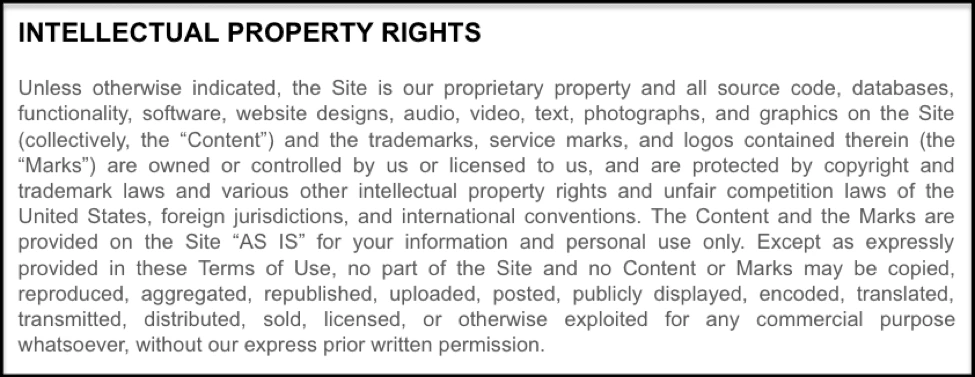Theft is a major concern for every business, as losing property almost always results in a loss of profit. For online businesses, however, the greatest concern is not the theft of physical goods, but that of intellectual property (IP). This is particularly true for small- and medium-sized business owners, who depend on their logos, trademarks, designs, and other property of the intellect to make a living.
An online business’s competitive advantage comes from and is built around its ideas, and if these ideas are not properly protected, they can be stolen—resulting in huge financial losses for the business. Incredibly, it is estimated that the cost of intellectual property theft to the US economy could be as high as [small businesses are now being targeted for IP theft](http://www.ipcommission.org/report/IP_Commission_Report_Update_2017.pdf “Cost of IP theft could be $600 billion>$600 billion annually.
Related: 9 red flags when working with a small business marketing agency
It’s important to take preventative measures to ensure that your online business does not fall victim to theft of any kind. So what can you do to safeguard your brand?
Below, we’ve compiled four ways you can protect your brand from the looming threat of intellectual property theft.
1. Trademark your brand
Intellectual property includes artistic and musical works, designs, images, literature and software—all of which help to develop your reputation in a given industry and build customer trust in your brand.
Copyright law covers a lot of the written material that can be found on your website or mobile app, but the components that make up your brand will not be protected through copyright protections alone.
Proprietary rights and trademark protections are sometimes established through consistent use in a given marketplace, but the internet is the wild west, and this kind of recognition in such an open and undefined marketplace is unlikely.
One of the best ways to protect your intellectual property is to register a trademark for your brand name, logo, designs, slogans, and any words associated with your brand. Obtaining a registered trademark for your brand’s IP will allow you to use the registered trademark symbol “®” in conjunction with these assets.
Not only will this deter would-be thieves from stealing your stuff, but it will also give you verifiable proof that you are the original owner of the trademarked material. You will have ground to stand on in the event that the issue is brought to court.
In order to register your brand materials, you must first submit an application with the US Patent and Trademark Office (USPTO). Registration is not automatic, nor is it guaranteed. Three months after you initially file your application, it will be reviewed by an examining attorney, who will check that your intellectual property is in compliance with USPTO rules and regulations.
Compliance is fairly straightforward, but your chance of success will most likely come down to whether you do two things:
Avoid likelihood of confusion
According to the USPTO, “likelihood of confusion” exists if they determine that the applicant’s marks are similar in appearance, sound, meaning or pronunciation to another and the goods or services provided by the two companies are similar enough for consumers to mistakenly believe they’re from the same company.
In order to avoid likelihood of confusion and get your IP certified, you must ensure that the IP of others in your industry is not similar to yours. You can do this by performing a trademark search in the USPTO trademark database.
Reduce similarity with established entity
Trademark registration applications are often declined based on their similarities with already established entities—both public and private. Your application may be refused on these grounds whether the established entity has a trademark of its own or not.
Established entities can include surnames, geographic locations, an individual’s name or likeness, and the names of books and/or movies.
As long as you avoid similarities with these types of entities, you will surely see your trademark application get accepted, and you can continue protecting your brand from IP theft.
2. Link your brand to a source
Generic intellectual property is much more easily replicated, copied and stolen—and thus more likely to be targeted for theft. This is illustrated by the fact that the most counterfeited brands in the world are Nike, Apple and Rolex, which all have relatively simple branding designs and logos.

You can make your brand stand out and decrease the chance of falling victim to intellectual property theft by creating branding material that has greater complexity. One way to achieve this is by linking it to a source.
Your brand can be linked to any kind of attributional source—from names and dates to locations and styles.
For example, if your company were one that (God forbid) sold fidget spinners, you may have adopted a name like “Super Spinners.” Unfortunately, while your company may in fact be super, it also has generic and easily replicated branding. Adding a source to the brand will change that completely. Something like “Silly Steve’s Super Spinners” not only makes it less generic and thus, more appealing, but also more difficult to copy.
This concept applies not only to naming schemes, but also to your logos, slogans, and other words associated with your company.
Attributing a source to your brand will make it a lot more unique—and a lot less likely to become the victim of IP theft.
3. Include an intellectual property clause in your terms & conditions
From a legal standpoint, it’s important to protect yourself and your intellectual property in writing. The best way to achieve this is with a comprehensive terms and conditions (T&C) agreement posted in a conspicuous location on your website or mobile app.
A terms and conditions agreement is a legal statement where you outline the rules and guidelines that users must agree with and adhere to in order to do business with you. It is a fundamental policy for your business and one that will give you the legal backing to deal with abuses and unruly users.

It is within your T&C agreement that you should include an intellectual property clause. This is where you state that all intellectual property—including but not limited to copyrighted material and trademarks—is owned by you and/or the company, and that you have proprietary rights to that material.
Not only will this disclosure give you legal grounds to fight intellectual property theft and copyright infringement, but it might also deter potential thieves from going through with it. They’ll see that you’ve taken precautionary steps to protect your brand, and that you will be vigilant in safeguarding your investment.
It’s important not to limit your IP rights. The wording is crucial and will determine whether your property is properly protected. Consult with a lawyer when drafting this section of the policy to ensure you have full and complete coverage, or use a terms and conditions generator online.
4. Stay vigilant
Legal implications aside, the theft of your intellectual property can have hugely negative effects on your brand—and particularly your market share. If gone unnoticed and unchecked, your stolen IP and branding could carve into your customer base and revenue. It could take years to recover completely from those losses, if ever.
It is extremely important to stay vigilant and monitor your competitors for potential thievery. However, constant monitoring of other sites and businesses is an arduous and time-consuming task.
Luckily, there is software out there that can aid in the battle against IP theft. This software scours the internet for potential matches with your brand and reports back with any infringements. It frees you up to focus on other business matters.
There are also intellectual property agents you can hire to help with the process. They are often licensed attorneys who are trained in intellectual property law. While these agents will be more expensive than computer software (or doing it yourself), the services they offer may end up being invaluable to your brand and the longevity of your business.
Your brand and the intellectual property associated with it are extremely valuable and worth protecting. Litigation and legal proceedings are last resorts, and they shouldn’t be relied on to keep your brand safe. While it’s impossible to completely eradicate theft online, these are fundamental steps you can take to safeguard your investment and give you peace of mind.



